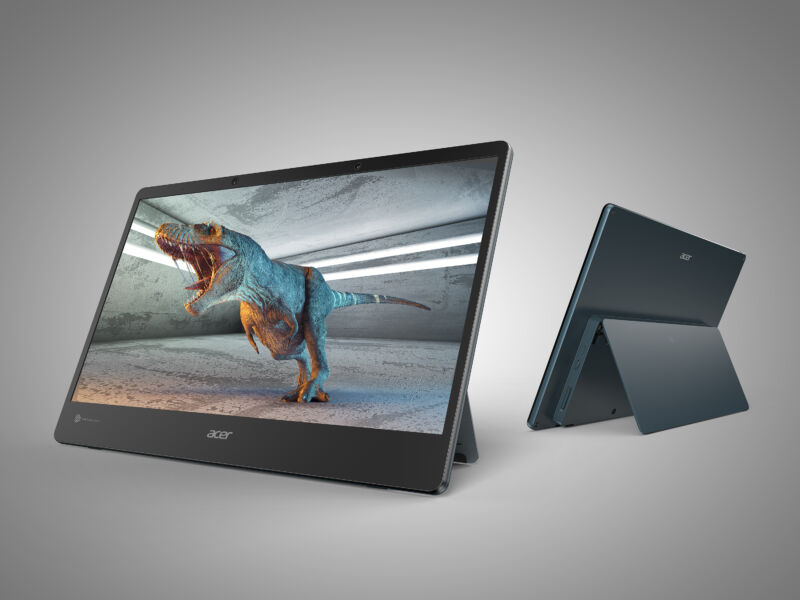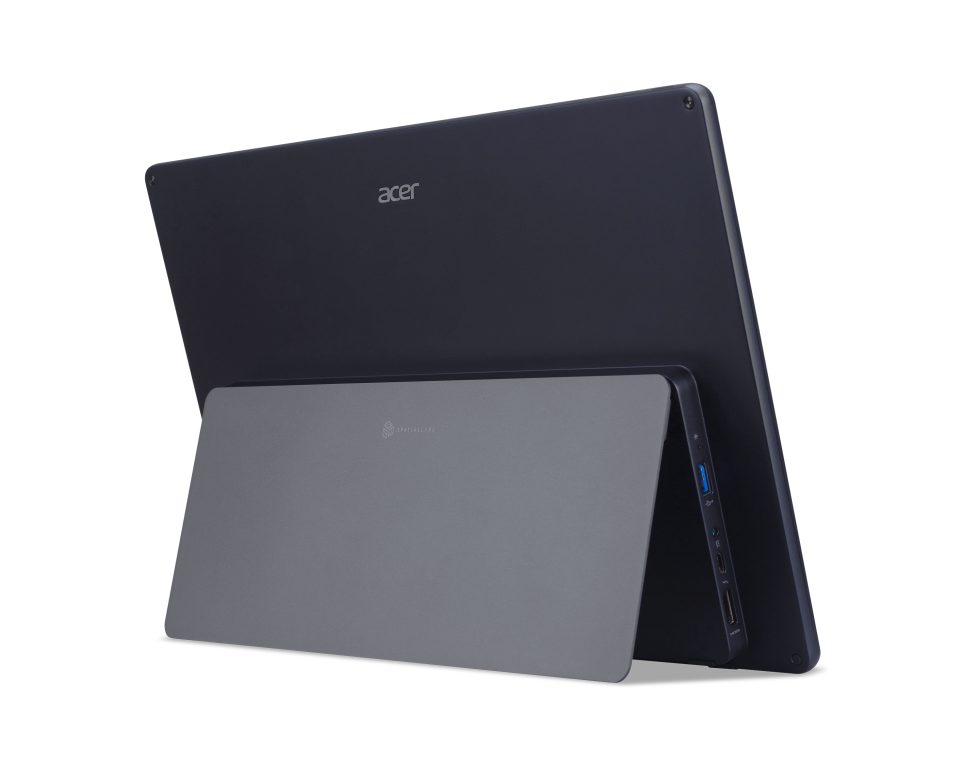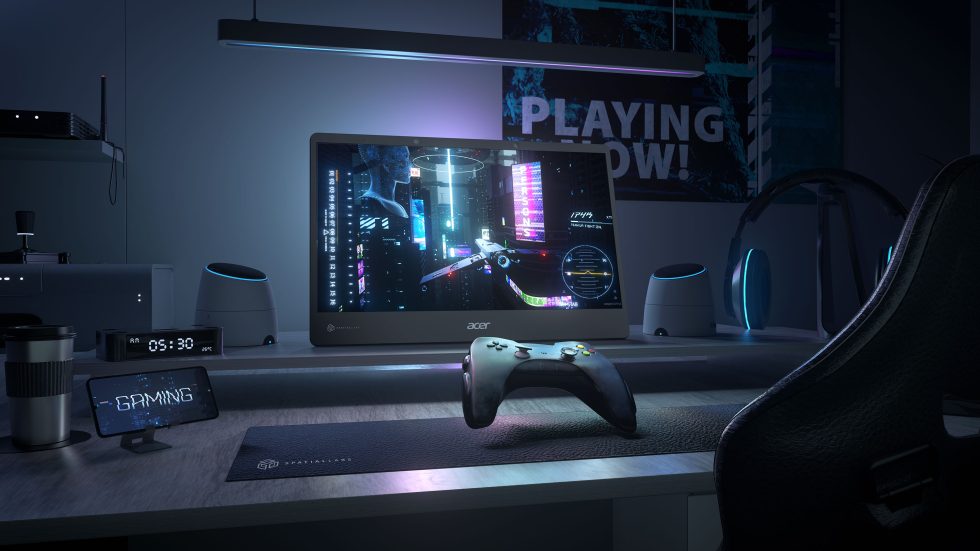
Good portable monitors improve your computing experience by providing more screen real estate. But two 4K portable monitors announced today, Acer's SpatialLabs View and SpatialLabs View Pro, have a trick up their sleeves: making content look like it's coming out of the screen. Using Acer's proprietary hardware-software solution, SpatialLabs, the monitors can convert 2D content, like supported games, photos, and CAD designs, into stereoscopic 3D.
Certified by Adobe and Autodesk, SpatialLabs uses a specialized optical lens, two eye-tracking cameras, and AI to make 2D work look 3D without pesky glasses or other clunky headgear. SpatialLabs works by creating a set of images for each eye and projecting them through the optical lens to where you're looking.
Acer's idea is that creators, like CAD designers, 3D animators, and developers, quickly see how their work looks in 3D. The stereoscopic 3D environment doesn't require time-consuming rendering, so it can provide a helpful and more immersive way to preview work.
Acer introduced SpatialLabs through its ConceptD 7 SpatialLabs Edition laptop in October and is now bringing it to entertainment and work-focused 15.6-inch portable monitors. It also announced a gaming laptop with the tech today.

Meant for personal use, the SpatialLabs View monitor claims to present supported games in stereoscopic 3D through the new SpatialLabs TrueGame platform.
Gaming in stereo 3D

"This is possible because games are mostly created with three dimensions in mind: Developers include information about depth into each scene and object they build. SpatialLabs leverages this already existing information in order to present the games in stereoscopic 3D," Acer said in its announcement. An Acer rep also pointed to using "shading and driver technologies" to get 3D and depth information from supported games.
Acer said that TrueGame would support more than 50 games upon release, including BioShock Infinite, Borderlands 2, Forza Horizon 4 and 5, God of War, No Man's Sky, The Witcher 3: Wild Hunt, and Tiny Tina's Wonderland. You can see the full list of games here. TrueGame will provide preconfigured 3D profiles for each title that will automatically launch when you play a supported game. An Acer rep claimed it will add more games "every month."
So what's the benefit of making gaming graphics look like they're popping out of a 15.6-inch screen? According to Acer, you can expect more spacious-looking rooms and objects that "appear genuinely layered." Before passing judgment, we have to see it in person but are curious how the effect might impact fast-paced action. The SpatialLabs View is also a smaller, high pixel density (282.4 pixels per inch) display with a 60 Hz refresh rate and response time of up to 30 ms, making it much slower than the 360 Hz desktop-sized gaming monitors and laptops available.
SpatialLabs also has a feature for generating a simulated stereo 3D image from 2D photos and videos, including online videos via YouTube.
A secondary 3D screen for creators
The SpatialLabs View Pro is more similar to the ConceptD 7 SpatialLabs Edition laptop in that it targets creative professionals. Acer said the portable monitor supports "all major file formats," including OBJ, FBX, STEP, STL, COLLADA, IGES, glTF, 3DS, BLEND, PLY, DAE, IGS, and Datasmith, enabling the use of 3D design software like Cinema 4D, Revit, and Solidworks.
The monitor also works with the SpatialLabs Model Viewer, which lets you bring over images, models, and animations from 3D software and view them in stereoscopic 3D. And if you use Autodesk Maya or Blender, you could edit on a normal screen in 2D and view those changes in real time in stereoscopic 3D on the portable monitor. Integration with 3D modeling platform Sketchfab, for downloading additional 3D assets, could also help Acer encourage more use cases.
Acer also sees the SpatialLabs View Pro attracting customers to kiosks and point-of-sale displays, equipping it with a VESA mount, hand gesture recognition, and up to a 5-hour battery life to help.

When you're not using the upcoming displays' 3D features, they're just regular 4K IPS panels. They claim a max brightness of 323 nits, which would be decent for a portable monitor, 100 percent coverage of the Adobe RGB color space, and 1,200:1 contrast ratios.
Moving the needle?
SpatialLabs was a niche use when Acer announced it in the fall, and that remains the case. But these monitors may move the needle a bit—at least more than the laptop did.
For one, they should be notably cheaper than the SpatialLabs laptop. Acer didn't share a price for the upcoming monitors, but the PC sells outside the US for 3,500 pounds/4,000 euros (about $4,366/$4,216).
Portable monitors are also a more approachable path to stereoscopic 3D than investing in a computer. Of course, the portable monitors assume you already have the computing capabilities to drive your 3D apps and SpatialLabs. Acer told Ars Technica that it recommends the following CPUs and GPUs for SpaitalLabs:
- Desktops: Intel Core i7 or higher / RTX 2080 or higher
- Laptops: Intel Core i7 or higher / RTX 3070 TI or higher
It remains to be seen if SpatialLabs can work with games in a way that looks good and doesn't hinder gameplay or induce nausea. Competitive gamers will opt for something with a higher refresh rate, but it's also hard to imagine more casual gamers flocking to the SpatialLabs View for stereoscopic 3D gaming. That's especially true considering that the SpatialLabs View will cost way more than most desktop-sized gaming monitors at $1,099 "this summer."
Having a second screen dedicated to the 3D experience seems more natural for creators and developers already working in this space, especially if it's executed well. But dealing with a smaller screen and finding the proper use is a pertinent obstacle for professionals. Creatives may also be hesitant to become dependent on somewhat new technology for critical work.
Acer didn't share a price or release date for the SpatialLabs View Pro.
Editor's note: This article was updated with specs recommendations from Acer.
Ars Technica may earn compensation for sales from links on this post through affiliate programs.
reader comments
51